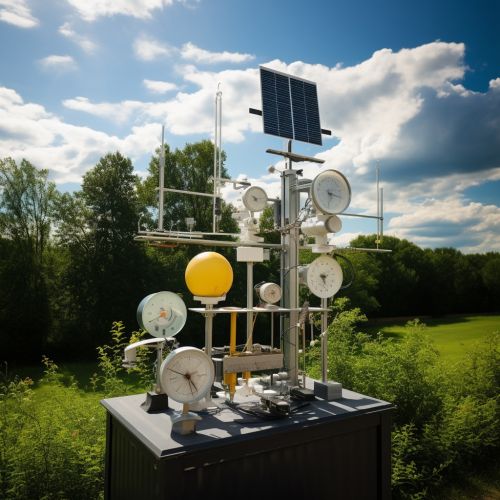Weather station
Introduction
A weather station is a facility, either on land or sea, with instruments and equipment for measuring atmospheric conditions to provide information for weather forecasts and to study the weather and climate. The measurements taken include temperature, atmospheric pressure, humidity, wind speed, wind direction, and precipitation amounts. Sophisticated weather stations are called meteorological stations, or weather observatories, and are typically located on land, while simpler devices to measure temperature, precipitation, and wind speed are called weather stations and can be located on both land and sea.
History
The development of the weather station dates back to ancient times. In 1441, the Korean king Sejong invented the first standardized rain gauge. These were sent throughout the Joseon Dynasty as an official tool to assess land taxes based on a farmer's potential harvest. In the 17th century, the invention of the mercury barometer by Evangelista Torricelli and the development of the thermometer significantly advanced the field of meteorology.


Types of Weather Stations
There are several types of weather stations, ranging from basic home weather stations to professional-grade weather stations that provide highly accurate and reliable data.
Home Weather Stations
A home weather station is a relatively simple weather station that provides information for home weather observation. These weather stations are typically wireless and come with a variety of features, such as indoor and outdoor temperature and humidity readings, barometric pressure, wind speed and direction, dew point, and rainfall.
Professional Weather Stations
Professional weather stations are more complex and provide more accurate weather data. These weather stations are often used by meteorologists, researchers, and weather enthusiasts. They include high-quality sensors for measuring temperature, humidity, barometric pressure, wind speed and direction, rainfall, UV index, and solar radiation.
Agricultural Weather Stations
Agricultural weather stations are specifically designed to meet the needs of farmers, horticulturists, and gardeners. They provide information on weather conditions that are crucial for crop growth and health, such as temperature, humidity, rainfall, wind speed and direction, solar radiation, and leaf wetness.
Maritime Weather Stations
Maritime weather stations, also known as weather buoys, are devices which collect weather and ocean data from the world's oceans. They are equipped with weather sensors and oceanographic sensors to measure parameters such as wind speed and direction, air and water temperature, wave height, and salinity.
Weather Station Instruments and Measurements
Weather stations use a variety of instruments to measure different atmospheric conditions. These measurements are crucial for weather prediction, climate modeling, agricultural and forestry management, and more.
Thermometer
A thermometer is used to measure the air temperature. The most common type in use today is the digital thermometer, which uses electronic sensors to measure temperature.
Barometer
A barometer is used to measure atmospheric pressure. It can help to forecast short term changes in the weather. Some digital barometers can track pressure trends for up to 24 hours and can be used to predict storms and fair weather.
Hygrometer
A hygrometer is used to measure the moisture content in the atmosphere, or humidity. There are several types of hygrometers, including electrical and hair tension hygrometers.
Anemometer
An anemometer is used to measure wind speed. The most common type is the cup anemometer, which has three or four cups that catch the wind and spin a rotor.
Wind Vane
A wind vane, or weather vane, is used to measure wind direction. It is typically installed at the highest point of a structure, like a rooftop.
Rain Gauge
A rain gauge is used to measure the amount of rainfall over a set period of time.
Pyranometer
A pyranometer is used to measure solar radiation. It is commonly used in meteorology, climatology, solar energy studies, and building physics.
Data Collection and Reporting
Weather stations collect data on a continuous basis. This data is then analyzed and used for various purposes, such as weather forecasting, climate research, and in various fields such as agriculture, forestry, and hydrology. The data is also shared with various weather services through networks like the National Weather Service (NWS) in the United States, the Met Office in the United Kingdom, and the Bureau of Meteorology in Australia.
